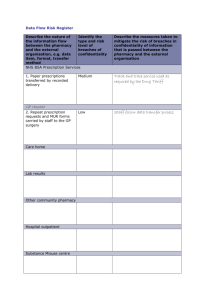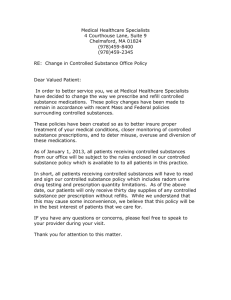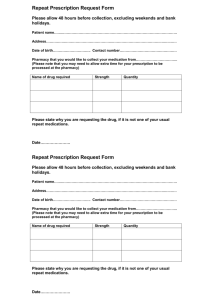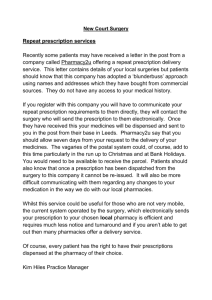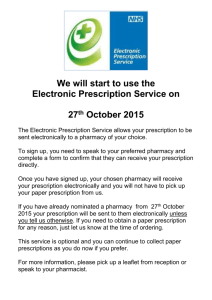By Jose Julio Vela, J.D., LL.M. Candidate (Health Law)
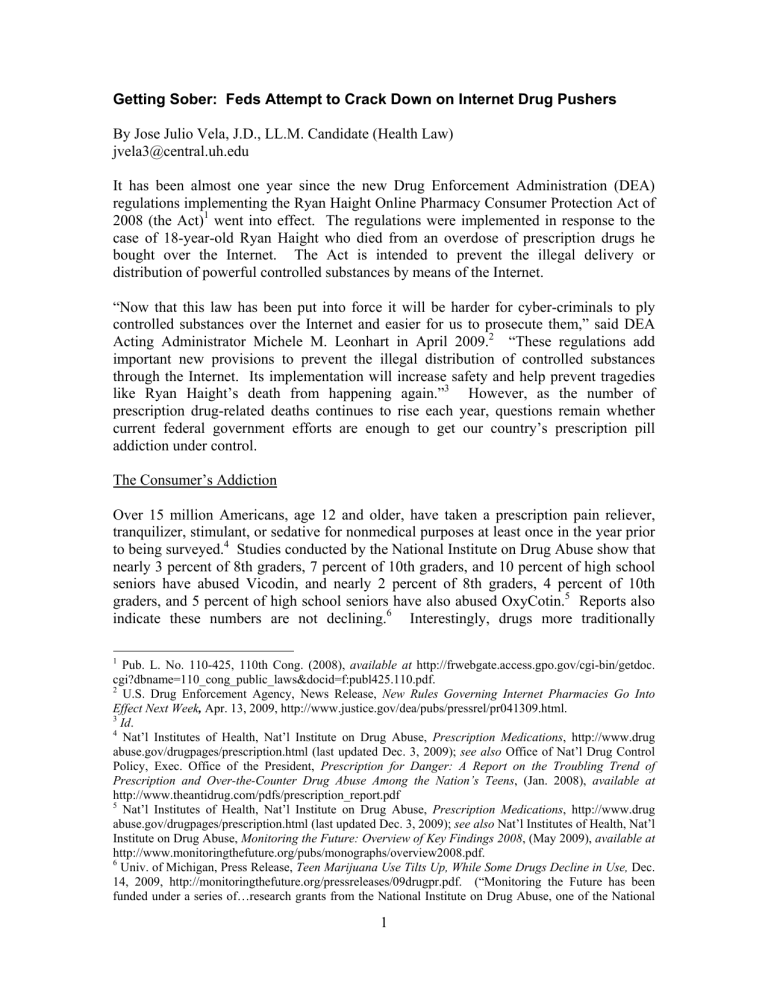
Getting Sober: Feds Attempt to Crack Down on Internet Drug Pushers
By Jose Julio Vela, J.D., LL.M. Candidate (Health Law) jvela3@central.uh.edu
It has been almost one year since the new Drug Enforcement Administration (DEA) regulations implementing the Ryan Haight Online Pharmacy Consumer Protection Act of
2008 (the Act)
1
went into effect. The regulations were implemented in response to the case of 18-year-old Ryan Haight who died from an overdose of prescription drugs he bought over the Internet. The Act is intended to prevent the illegal delivery or distribution of powerful controlled substances by means of the Internet.
“Now that this law has been put into force it will be harder for cyber-criminals to ply controlled substances over the Internet and easier for us to prosecute them,” said DEA
Acting Administrator Michele M. Leonhart in April 2009.
2
“These regulations add important new provisions to prevent the illegal distribution of controlled substances through the Internet. Its implementation will increase safety and help prevent tragedies like Ryan Haight’s death from happening again.”
3
However, as the number of prescription drug-related deaths continues to rise each year, questions remain whether current federal government efforts are enough to get our country’s prescription pill addiction under control.
The Consumer’s Addiction
Over 15 million Americans, age 12 and older, have taken a prescription pain reliever, tranquilizer, stimulant, or sedative for nonmedical purposes at least once in the year prior to being surveyed.
4
Studies conducted by the National Institute on Drug Abuse show that nearly 3 percent of 8th graders, 7 percent of 10th graders, and 10 percent of high school seniors have abused Vicodin, and nearly 2 percent of 8th graders, 4 percent of 10th graders, and 5 percent of high school seniors have also abused OxyCotin.
5
Reports also indicate these numbers are not declining.
6
Interestingly, drugs more traditionally
1
Pub. L. No. 110-425, 110th Cong. (2008), available at http://frwebgate.access.gpo.gov/cgi-bin/getdoc.
2 cgi?dbname=110_cong_public_laws&docid=f:publ425.110.pdf.
U.S. Drug Enforcement Agency, News Release, New Rules Governing Internet Pharmacies Go Into
3
Effect Next Week, Apr. 13, 2009, http://www.justice.gov/dea/pubs/pressrel/pr041309.html.
4
Id .
Nat’l Institutes of Health, Nat’l Institute on Drug Abuse, Prescription Medications , http://www.drug abuse.gov/drugpages/prescription.html (last updated Dec. 3, 2009); see also Office of Nat’l Drug Control
Policy, Exec. Office of the President, Prescription for Danger: A Report on the Troubling Trend of
Prescription and Over-the-Counter Drug Abuse Among the Nation’s Teens , (Jan. 2008), available at
5 http://www.theantidrug.com/pdfs/prescription_report.pdf
Nat’l Institutes of Health, Nat’l Institute on Drug Abuse, Prescription Medications , http://www.drug abuse.gov/drugpages/prescription.html (last updated Dec. 3, 2009); see also Nat’l Institutes of Health, Nat’l
Institute on Drug Abuse, Monitoring the Future: Overview of Key Findings 2008 , (May 2009), available at http://www.monitoringthefuture.org/pubs/monographs/overview2008.pdf.
6
Univ. of Michigan, Press Release, Teen Marijuana Use Tilts Up, While Some Drugs Decline in Use, Dec.
14, 2009, http://monitoringthefuture.org/pressreleases/09drugpr.pdf. (“Monitoring the Future has been funded under a series of…research grants from the National Institute on Drug Abuse, one of the National
1
associated with abuse, such as cocaine and methamphetamine have seen a decline in use within this age group. Even cigarette smoking amongst high school students is at its lowest in over a decade.
7
According to the International Narcotics Control Board, an independent and quasijudicial monitoring body for the United Nations, the United States is the largest consumer of narcotic drugs in the world.
8
Startling figures from the U.S. Centers for Disease
Control and Prevention indicate that 46.9 percent of the adult population in this country has used at least one prescription drug in the past month of being surveyed, and 21.1 percent have used three or more.
9
Prescription-related deaths are now the biggest cause of fatal drug overdoses.
10
Additionally, approximately 120,000 Americans go to the emergency room each year after overdosing on opioid painkillers.
11
The data indicates the U.S. spends over $200 billion dollars on prescriptions drugs.
12
Estimates show that around $15 to $20 billion of that comes from prescription drugs obtained via the
Internet.
13
Over 200 million Americans have access to the Internet, and many are realizing how easy it is to get their drug of choice with just a click of a button.
14
The Law
The Ryan Haight Online Pharmacy Consumer Protection Act amended the Controlled
Substances Act (CSA) and Controlled Substances Import and Export Act (CSIE) by adding several new provisions to prevent the illegal distribution and dispensing of controlled substances by means of the Internet. The Act applies to all controlled substances in all schedules. The most important provisions of the Act include the valid prescription requirement, the modified registration requirement for online pharmacies, and the two newly created criminal offenses.
Institutes of Health. The lead investigators, in addition to L.D. Johnston, are Patrick O’Malley, Jerald
Bachman, and John Schulenberg—all research professors at the University of Michigan’s Institute for
Social Research. The findings…will be published in the forthcoming volume: Johnston, L.D., O’Malley,
P.M., Bachman, J.G., & Schulenberg, J. E. (2010), Monitoring the Future National Results on Adolescent
Drug Use: Overview of Key Findings, 2009 ”).
7
Nat’l Institutes of Health, Nat’l Institute on Drug Abuse, Press Release, Teen Methamphetamine Use,
Cigarette Smoking at Lowest Levels in NIDA's 2009 Monitoring the Future Survey , Dec. 14, 2009,
8 http://www.drugabuse.gov/newsroom/09/NR12-14.html.
Rpt. of the Int’l Narcotics Control Bd. for 2008 on the Implementation of Art. 12 of the U.N. Conv’n against Illicit Traffic in Narcotic Drugs and Psychotropic Sub. of 1988, Pt. Four, Statistical Inform’n on
Narcotic Drugs, at p. 194, available at http://www.incb.org/pdf/technical-reports/narcotic-
9 drugs/2009/part_4_all_2009.pdf.
Nat’l Center for Health Stats., Health, United States, 2009: With Special Feature on Medical Technology ,
(2010), available at http://www.cdc.gov/nchs/data/hus/hus09.pdf#095.
10
Liz Szabo, Prescriptions Now Biggest Cause of Fatal Drug Overdoses , USA T ODAY , Oct. 2, 2009, available at http://www.usatoday.com/news/health/2009-09-30-drug-overdose_N.htm.
11
12
Id.
13
See Health, United States, 2009, supra note 9.
Bryan A. Lian and Time Mackey, Searching for Safety: Addressing Search Engine, Website, and
Provider Accountability for Illicit Online Drug Sales , 35 A
M
.
J.L.
& M
ED
. 125, 128 (2009), available at http://www.safemedicines.org/resources/LiangMackeyAJLM.pdf.
14
See U.S. Census Bureau, Statistical Abstract of the United States: 2008 , available at http://www.census.gov/prod/2007pubs/08abstract/infocomm.pdf.
2
First, the Act mandates with limited exceptions, that the dispensing of controlled substances by means of the Internet be predicated on a valid prescription involving at least one in-person medical evaluation by a physician.
15
Prior to the Act, the lack of an in-person medical evaluation had generally only triggered a “red flag.” Now, except in certain circumstances, the Act makes it a per se violation of the CSA for a practitioner to issue a prescription for a controlled substance over the Internet without having conducted at least one in-person medical evaluation. Further, even where the prescribing practitioner has complied with this requirement, the practitioner must still prescribe the controlled substance for a legitimate medical purpose.
16
Second, the Act also requires any person who operates a website that is an “online pharmacy” to obtain a modification of its DEA pharmacy registration to expressly authorize sales over the internet.
17
The Act broadly defines “online pharmacy” to not only include DEA approved online pharmacies, but also includes those unapproved websites located within the United States and abroad who facilitate the delivery, distribution, or dispensing of controlled substances by the Internet to any person within the United States.
18
Only DEA-registered pharmacies are eligible under the Act to modify their registration to allow for online sales.
19
Thus, those non-DEA-registered online pharmacies that had been facilitating Internet sales of controlled substances prior to the Act are now expressly prohibited from continuing to do so.
20
Moreover, any online pharmacy that modifies its DEA-registration and becomes able to lawfully dispense controlled substances online must provide certain declarations to consumers on its website to indicate its compliance with the Act.
21
Finally, approved online pharmacies will have to report to the DEA on a monthly basis the total amount of each controlled substance they dispense if the amount meets a minimum threshold.
22
The Act also adds two new criminal provisions to the CSA. As of April 13, 2009, it is illegal under federal law to “deliver, distribute, or dispense a controlled substance by means of the Internet, except as authorized by the CSA, or to aid or abet such activity.”
23
15
74 Fed. Reg. 15,596 15,597 (Apr. 6, 2009) (to be codified at C.F.R. pt. 1300, 1301, 1304, et al.
)
16
Id.
; see also 21 C.F.R. § 1306.05(a) (2009); United States v. Moore , 423 U.S. 122 (1975).
17
74 Fed. Reg. 15,596 15,597 (Apr. 6, 2009) (to be codified at C.F.R. pt. 1300, 1301, 1304, et al.
); see 21
U.S.C. §§ 832(f), 841(h)(1) (2009).
18
19
21 U.S.C. § 802(52) (2009).
20
21 U.S.C. § 832(f) (2009).
21
74 Fed. Reg. 15,596 15,597 (Apr. 6, 2009) (to be codified at C.F.R. pt. 1300, 1301, 1304, et al.
)
Id at 605; 21 U.S.C. § 831(a); 21 U.S.C. § 831 (2009). Internet Pharmacy Site Disclosure Information : disclosures include identifying pharmacy as it appears on DEA registration, phone number and email address, full information on the pharmacist, certification that the pharmacy is registered in compliance with the Act, names and addresses of any practitioner who has a contractual relationship to provide medical evaluations or issue prescriptions for controlled substances through referrals from the website, among others.
22
21 U.S.C. § 827(d)(2) (2009); the monthly threshold is either (A) 100 or more prescriptions for controlled substances filled by the pharmacy or (B) 5,000 or more total dosage units of controlled substances dispensed.
23
21 U.S.C. § 841(h)(1) (2009).
3
The Act contains a non-exclusive list of conduct which would violate this provision.
24
Moreover, the Act also excludes certain categories of conduct from criminal liability.
For example, the Act still allows DEA registered nonpractioners, such as manufacturers and distributors, to utilize the Internet to carry out business activities authorized by their previous DEA-registration, and websites may still be used to advocate the use of controlled substances or contain price information so long as they do so without attempting to facilitate an actual transaction involving a controlled substance.
25
The second new criminal offense makes it a felony for any person to “knowingly or intentionally” use the Internet to “advertise the sale of, or offer to sell, distribute, or dispense, a controlled substance,” where such activity is not authorized by the CSA.
26
Thus, any person who places an Internet advertisement that offers to sell or directs traffic to a non DEA-registered online pharmacy that sells prescriptions for controlled substances is criminally liable under the Act.
27
It is not necessary that the person placing the advertisement actually engage in a transaction involving a controlled substance to violate this provision. Therefore, merely placing an Internet advertisement designed to facilitate an illegal sale of controlled substance amounts to a felonious conduct.
28
Additionally, the new criminal provision also applies to the Controlled Substances Import and Export Act (CSIEA).
29
As a consequence, any placement of an Internet advertisement that offers to ship controlled substances into the United States also violates
21 U.S.C. § 843(c)(2)(A). Reports indicate that an estimated 130 million packages containing counterfeit drug products enter the U.S. each year through the U.S. mails.
30
Conclusion
The Department of Health and Human Services (HHS) projects U.S. prescription drug spending to increase to $515.7 billion in 2017, a 138 percent increase from 2006.
31
In previous testimony in front of Congress, the FDA reported only 372 Internet-related criminal investigations, 150 Internet-related arrests and 92 convictions, and 100 open
Internet criminal investigations.
32
The HHS Task Force on Drug Importation revealed
24
21 U.S.C. § 841(h)(2) (2009); examples of conduct include, among others: delivering, distributing, or dispensing controlled substances via an online pharmacy without modifying your DEA status; serving as an agent intermediary, or other entity that uses the Internet to bring together a buyer and seller to engage in the dispensing of a controlled substance in a manner not allowed by law; offering to fill a prescription for controlled substances based solely on an online medical questionnaire.
25
26
21 U.S.C. § 841(h)(3) (2009).
27
21 U.S.C. § 843(c)(2)(A) (2009).
28
21 U.S.C. § 843(c)(2)(A) (2009).
Implementation of the Ryan Haight Online Pharmacy Consumer Protection Act of 2008, 74 Fed. Reg.
15,596 15,605 (April 6, 2009) (to be codified at C.F.R. pt. 1300, 1301, 1304, et al.)
29
30
21 U.S.C. § 842(c)(2)(A) (2009).
See Press Release, Rep. Steve Buyer (R-Ind.), Cracking Down on Counterfeit Prescription Drug
Distribution , (Apr. 22, 2008), available at http://www.house.gov/list/press/in04_buyer/counterfit_ perscription_drugs.html.
31
Kaiser Family Found’n Prescription Drug Trends , (Sept. 2008), available at http://www.kff.org/rxdrugs/ upload/3057_07.pdf.
32
Pharmaceutical Sales Over the Internet: Hearing Before the H. Comm. on Government Reform, 108th
Cong. (2003) (statement of William Hubbard, Associate Commissioner for Policy, Planning, and
4
that only 16.9 full-time FDA employees were responsible for analyzing suspected illegal online drug sales in addition to their regular duties.
33
A study conducted by the National
Center on Addiction and Substance Abuse at Columbia University found that around twice as many of the medications purchased from an online pharmacy are shipped from a foreign country than those that are shipped from within the U.S.
34
With about half of all
Americans on at least one prescription pill a day, billions of green backs spent each year, and over 200 million internet users, our regulators have their work cut out for them. Will the Ryan Haight Online Pharmacy Consumer Protection Act of 2008 be the rehab our country needs to get sober, or just fundamentally change how online prescription drug dealers get around the law? Likely the latter, but for what it’s worth, it sure is a step in the right direction.
Health Law Perspectives (April 2010)
Health Law & Policy Institute
University of Houston Law Center http://www.law.uh.edu/healthlaw/perspectives/homepage.asp
The opinions, beliefs and viewpoints expressed by the various Health Law Perspectives authors on this web site do not necessarily reflect the opinions, beliefs, viewpoints, or official policies of the Health Law & Policy Institute and do not constitute legal advice. The Health Law & Policy
Institute is part of the University of Houston Law Center. It is guided by an advisory board consisting of leading academicians, health law practitioners, representatives of area institutions, and public officials. A primary mission of the Institute is to provide policy analysis for members of the Texas Legislature and health and human service agencies in state government.
Legislation, U.S. Food and Drug Adm’n), available at http://http://www.fda.gov/NewsEvents/
Testimony/ucm161404.htm.
33
Dep’t of Health & Human Servs., HHS Task Force on Drug Importation, Report on Prescription Drug
Importation , at p. 56. (Dec. 2004), available at http://archive.hhs.gov/importtaskforce/Report1220.pdf.
34
Nat’l Drug Intelligence Ctr., National Drug Threat Assessment 2008 : Pharmaceutical Drugs , (Oct.
2007), available at http://www.usdoj.gov/ndic/pubs25/25921/pharm.htm.
5
